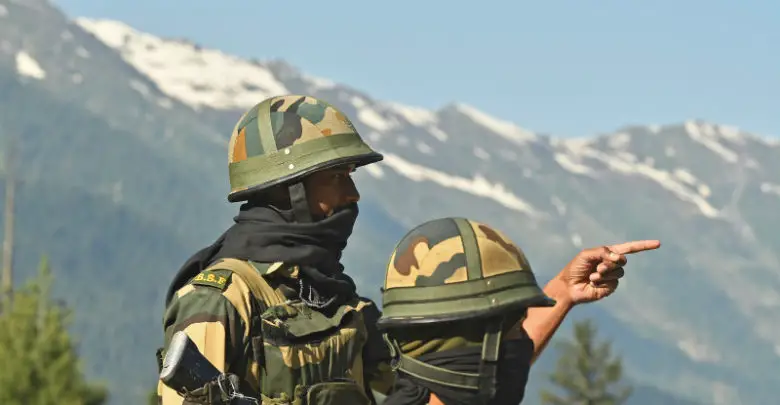
Despite shared economic opportunities, border disputes continue to haunt India and China’s relationship. After 60 years, the two countries are once again engaged in a bloody mini-war in the Himalayas.
During recent clashes in the Galwan Valley, both have killed each other’s soldiers, yet there is a greater sense of loss in India. In the battle of perceptions, the Chinese seem to be ahead in this current round. Uncertain calm prevails on the India-China borders. However, those seeking a quick solution are likely to be disappointed.
China-India tensions will persist because they are tethered to the ensuing US-China Cold War, which itself is a titanic battle over who will dominate the world – sea-power or land power. America rules the waves and sets the terms and conditions for the vast majority of global commerce. China, on the other hand, is busy building a land bridge across Eurasia, which would undermine US maritime dominance.
Wake-Up Call
There is little doubt that India under Prime Minister Narendra Modi has fostered the nation’s strategic embrace of the US. Both have been deliberating on their collaborative military posture in the Indo-Pacific to contain China and a more conscious collective effort by like-minded (democratic) countries to curtail Chinese president Xi Jinping’s aggressive foreign policy. Hence, the current India-China dispute must be viewed in a broader Indo-Pacific perspective.
To influential American observers such as Michele Flournoy, former under-secretary of defense for planning, the Sino-Indian border confrontation should “serve as a wake-up call to accelerate and deepen security co-operation among like-minded states.” Flournoy claims that while the region’s geopolitics is often portrayed as a US-China contest, in reality, there is a group of democracies with increasingly converging interests.
Many in India and the US see the current tense situation between India and China as an opportunity to push for India’s overt alignment with the US-led security intuitive in the Indo-Pacific.
US’ Broader Vision of Containing China
For the US, the border dispute in the Himalayas is just one of several flashpoints in Asia: Taiwan’s independence; Tibetan freedom; Hong Kong’s democracy and relative autonomy; and freedom of navigation in the South China Sea.
Washington enjoys deep network connections in Taiwan, India, Hong Kong, and the South China Sea to spark flash points to pressurize and probe China, to make it react. China has been engaged aggressively, legally, economically, or militarily to secure its frontiers from a possible onslaught by the US or its allies.
For example, in the Himalayas, the Chinese have fortified their claim line through the use of force against India and a massive military buildup to avoid getting caught by surprise. In Hong Kong, the Chinese have approved a national security law, which they claim is directed to control subversive activities.
If America has simultaneously deployed, for the first time in many years, three aircraft carriers, then China too has been active since the outbreak of the global pandemic, to beef up its research and military aviation capabilities on the Fiery Cross Reef and Subi Reef.
Specter of Chinese Land-Power Haunts American Strategists
US maritime power is asserting its reach and range to let its allies know that the “maximum pressure” game on China is underway. Offensive realism, consisting of assertive containment and deterrence, is America’s new theoretical and political mantra against China.
There is a bipartisan resolve in the US that a continental power like China cannot be allowed to change the international political order designed by the maritime world. But how is a conflict between Indian and Chinese armies 14,000 feet above sea-level related to US naval dominance?

“The Army is a projectile to be fired by the navy,” argued Admiral Jackie Fisher, British First Sea Lord (1904-1910) summing up naval historian and geo-strategist Julian Corbett’s view that it was critical for a sea power to influence operations on land.
For maximum international trade to flow on the oceans, land borders must remain sealed. The army helps the sea power ensure that borders stay tense through conflicts while trade continues to seek the smooth sea lines of communication under the watchful eyes of the superior naval forces and marine service industry. This is exactly how British and American sea power ensured that 90 percent of global trade continues to use oceanic routes.
China, the great disruptor of the 21st-century, is challenging this 200-year-old maritime order by building alternative supply lines across Eurasia, many of which will make the existing sea lines of communication redundant. Besides the loss of dollars and technological hegemony, a world map that shows a connected Eurasia and an isolated America through the systemic undermining of sea power haunts American strategists.
Key Anglo-American Strategy: Keeping Eurasia Divided
The Americans were aware of this geographic imperative when they took over the reins of the maritime domain from Britain after World War II. America’s Eurasian dilemma got heightened with the communists coming to power in China in 1949.
The specter of socialist supply lines running from China to Poland via the Soviet Union led to the “China Lobby”, directed by Henry Luce (founder of Time magazine and advocate of “American Exceptionalism” and the “American Century”), which lamented the “loss of China” to Mao Zedong.
However, another strategic stream in the US saw Mao’s arrival in Beijing as an opportunity to contain the Soviet Union by causing a schism in the communist bloc. The Yugoslavian communist leader Joseph Tito, a staunch anti-Stalin activist, was America’s trump card in eastern Europe.
Mao was expected to shape up as the “Chinese Tito,” who would raise the banner of protest against Soviet domination of the communist bloc. Breaking the ideological affinity between China and the Soviet Union was one aspect of America’s grand strategy, but more important was to keep the two continental powers apart and to prevent them from building a Eurasian land bridge on which socialist trade would be plied free from the constraints on the flow of international trade imposed by maritime powers.
India’s Historic Role in the Great Game
The Indian elite got drawn into the geopolitical game of initiating the Sino-Soviet split. In the late 1950s, India-China relations nosedived. India got involved in US-driven covert operations inside Tibet. The border settlement issue suddenly sprang up as a core issue between China and the Soviet Union.
The Aksai Chin road connecting Xinjiang with Tibet became a bone of contention. India started claiming Aksai Chin as a part of its territory, and China retaliated by asking for Tawang. Before this, India had never raised the issue of Aksai Chin, and China had not objected to India hoisting its flag in Tawang in 1951.
This was also when the Soviet leader Nikita Khrushchev was impressing the West with his de-Stalinization drive and had started building bridges with the West by visiting Washington in 1959.
The US, however, was more interested in seeing New Delhi distancing from Beijing than in controlling India veering towards Moscow. Washington saw Moscow’s interest in the non-communist “swing states” such as India, Indonesia, and Egypt as a welcome development. This is exactly what was needed to convince the Chinese that the Soviets’ commitment to building a strong socialist bloc was a farce: they were more interested in expanding their imperial reach.
In the late 1950s, the US nudged India towards the Soviet Union. India started inching towards the Soviet Union and seeking its military hardware when Indo-US ties had hit a purple patch. India collaborated with America on the Tibet issue, and the US organized a massive economic aid package for it.
India-China War Exacerbated Sino-Soviet Rivalry
The 1962 India-China war offered a perfect setting to accentuate the differences between the two communist giants. China was irked by Moscow’s neutral stance on the India-China border skirmishes, which began in 1959 and culminated in a war in 1962. According to the assessment of Indian Intelligence Bureau Chief Bhola Nath Mullik, China went all out attacking the Soviet Union because the latter had not backed China in the Sino-Indian conflict.
In a post-war discussion with his intelligence personnel, Indian Prime Minister Jawaharlal Nehru mentioned some articles in the media that reflected Chinese fury against India and the Soviet Union. A 1963 CIA document titled Implications of Sino-Soviet Rupture for the US stated that, “for most practical purposes there was now an open split in Sino-Soviet relations. The virulence of the present confrontation, the directness of the most recent insults and accusations at Moscow, and the theological certainty of both disputants reflect new dimensions of antagonism too extensive to be bridged.”
The alignment of the Indian elite with their counterparts in America to push their class goals then became one of the most critical factors for the causes of the India-China war of 1962.
The dominant elite in India showed great eagerness to confront the Chinese and settle the border dispute through the forward deployment of the military in disputed areas because it helped them achieve their domestic political goals.
One such goal was to defeat and demonize Indian communists for opposing the war and, secondly, to ensure the rise of conservatives within the ruling Congress party by projecting left-liberals like Krishna Menon, then defense minister, as the chief culprit for India’s defeat at the hand of Chinese. The war also helped Rashtriya Swayamsevak Sangh (RSS), the Hindu cultural-political outfit, to parade itself as a nationalist force. This was essential for the RSS because its role in the national freedom struggle was negligible.
Back to the Future With Trump-Modi Axis?
A similar class-alignment is visible today when Donald Trump’s administration launched a virulent hate campaign and trade war against the Communist Party of China to browbeat it into halting all its endeavors to alter the global power matrix by building alternative global supply lines running through Eurasia.
The current India-China conflict is connected to Anglo-American geopolitical plans to halt the Chinese from reaching the Arabian Sea through a much shorter route via Pakistan. The maritime powers see the development of the China-Pakistan Economic Corridor (CPEC) as a direct assault on their sea power strategy that aims to choke Chinese merchant shipping in the Strait of Malacca between the Indonesian island of Sumatra and Malaysia.

India is opposed to the CPEC, a flagship project of the Belt and Road Initiative launched by Xi in 2013, because it passes through Gilgit-Baltistan (GB), a Pakistani province in the north, to reach the Chinese-operated Gwadar port in the south.
India considers GB, a critical hub that connects South and Central Asia, to be under the illegal Pakistani occupation. India has become more vocal about GB only after the CPEC project picked up momentum in 2014. India’s Minister of Home Affairs, Amit Shah, recently asserted that, “The boundaries of Jammu and Kashmir decided in our Constitution, and also in the Constitution of Jammu and Kashmir, includes PoK (Pakistan Occupied Kashmir) and Aksai Chin.”
Last year, after the bifurcation of Jammu and Kashmir, India issued a fresh set of maps that showed Aksai Chin and GB as parts of the Union territory of Ladakh. The Chinese objected and said India was unilaterally changing the status quo.
Galwan Valley – the flashpoint of the recent clashes between the Indian army and the People’s Liberation Army (PLA) of China is close to Aksai Chin – is the same area that became a bone of contention between the two Asian nations during the 1962 war.
The current Indian government brought the area back into the discourse, making it contentious once again. With the Indian establishment’s renewed resolve to reclaim regions in China and Pakistan, the security in the area became tense and has finally resulted in the brutal killings of soldiers.
As long as the subcontinent remains caught in the “territorial trap” and refuses to see its borders as opportunities, both Indian and Pakistani armies will continue to be used as projectiles fired by maritime America to achieve its broader goal of keeping the borders shut, the Eurasian landmass divided, and maximum trade flowing on US-controlled sea routes.
If continental China wants the land bridges to be secured, it will have to devise a different strategy that relies less on the use of force, and to befriend India.











